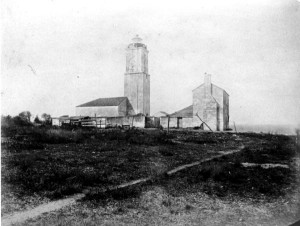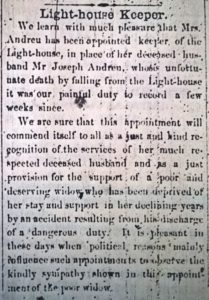The Old Spanish Watchtower

The Old Spanish Watchtower, manned by Menorcan keepers for most of its history (Photo Courtesy of the State Archives of Florida)
Florida’s territorial period began in the 1820s with the ratification of the Adams-Onís Treaty, which transferred the former Spanish colony to the United States. Though the newly acquired territory did not become a state until 1845, the U.S. government immediately set to work extending the young nation’s network of lighthouses into Florida. The U.S. Lighthouse Establishment converted an old Spanish watchtower in the territorial capital of St. Augustine into the territory’s first lighthouse and hired keepers to operate and maintain it. The early keepers came from a minority group in St. Augustine known as Menorcans.
The Menorcans of St. Augustine
Technically, the term Menorcan refers to someone from the island of Minorca, located off the coast of Spain in the Mediterranean Sea. The Menorcans of St. Augustine however, are descended from a group of about 1,400 Menorcan, Greek, Italian, Corsican, and French workers and family members that traveled to New Smyrna, south of St. Augustine, to work as indentured servants on Dr. Andrew Turnbull’s indigo plantation in 1768.
Deteriorating conditions on the plantation and poor treatment of the workers inspired the Menorcan workers and their families to petition the British governor of East Florida, Patrick Tonyn for permission to move to St. Augustine. In 1777, the remaining Menorcans, now numbering less than 700, walked to their new home. Their background living on the Mediterranean made them excellent fishermen, dock workers, pilots, and many served as lighthouse keepers.
St. Augustine’s Menorcan Lightkeepers
The first lighthouse keeper in the newly lit St. Augustine Lighthouse was Menorcan Juan Andreu, born at the New Smyrna plantation in 1774. His parents, Antonio and Agueda came to Florida as teenagers from Minorca and married in New Smyrna in 1772. Antonio was a ship carpenter. Juan Andreu served as lighthouse keeper from 1824 to 1845. The US Coast Guard considers Juan the first Hispanic-American man to serve in the USCG (including its predecessor services like the Lighthouse Service) and the first one to command a shore installation.
We have no information on lighthouse keepers between 1845 and when another Menorcan, Juan Carrera, took over in 1849. Unlike Juan Andreu, Carrera was born in St. Augustine in 1791 to parents Juan and Maria who traveled to Florida from Minorca. The 1850 U.S. Census records Juan Carrera living at the lighthouse as keeper with his wife Frances and three grown children, who likely assisted their father with his nightly duties.
Robert Mickler took over for Juan Carrera in 1853. Mickler was born in St. Mary’s, GA in 1800 and moved to St. Augustine 14 years later. He married Ana Ortega, whose father Lazaro had arrived with the Menorcans in New Smyrna. Robert Mickler only served as lighthouse keeper for about a year before ceding the position to another Menorcan, Joseph Andreu.
Joseph Andreu, cousin of the first St. Augustine Lighthouse Keeper Juan Andreu, served as keeper from 1854 until his death in 1859. Joseph’s father Tomas was brother to Juan’s father, Antonio. Joseph died while painting the lighthouse when the scaffold he was on came free, plunging him roughly 60 feet to the ground.
His wife, Maria de los Dolores Mestre (Masters) Andreu was appointed keeper making her the first Hispanic-American woman to serve in the Coast Guard or its predecessor services and the first to command a federal shore installation. Maria was keeper until 1862 when the light was darkened during the Civil War. After the war, Siladonio Pellicer took over as keeper.
Siladonio’s grandfather, Francisco Pellicer, was a leader at the New Smyrna plantation and was a part of the delegation sent to British governor Patrick Tonyn to request permission to move to St. Augustine. Siladonio was born in 1832 and served as keeper at the St. Augustine Lighthouse from 1867 to 1873. In the 1870 U.S. Census, he is listed as keeper, living with his wife Urbana (called Emma in the census) and four children.
Siladonio was the last Menorcan to serve as lighthouse keeper at the lighthouse known as the Old Spanish Watchtower. During the last few years of Siladonio’s tenure, work began on the new St. Augustine Lighthouse and an emphasis on the federalization of what was now known as the Lighthouse Board brought in keepers from other parts of the country.
Learn more about the Menorcan heritage and influence in St. Augustine at the Menorcan Cultural Society and come visit the lighthouse to learn more about life as a lighthouse keeper.
Paul Zielinski is Director of Interpretation for the St. Augustine Lighthouse & Maritime Museum. He received his master’s degree in Public History from the University of West Florida and joined the lighthouse family in 2011.


